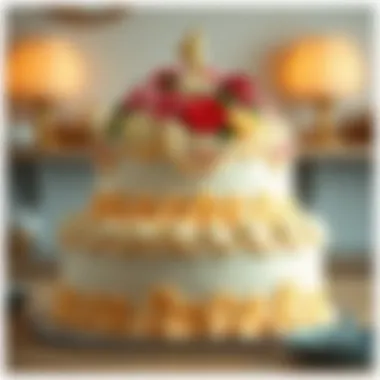Mastering the Craft of Baking Giant Cakes


Ingredients Breakdown
When embarking on the quest to bake a giant cake, understanding the ingredients is paramount. Each element plays a critical role, contributing not just to flavor but also to texture and overall success of the creation.
Primary Ingredients
At the heart of every cake are the primary ingredients:
- Flour: All-purpose flour is commonly used, providing the structure. The right gluten content is important for elasticity.
- Sugar: Granulated sugar adds sweetness and moisture, affecting the cake’s density.
- Eggs: They act as binders, providing structure and moisture. The number of eggs may vary depending on the recipe volume.
- Butter: Using unsalted butter adds richness and flavor. Choice between softened or melted butter can impact texture.
- Baking Powder and Baking Soda: These leavening agents are crucial for achieving that desired height.
- Milk or other liquids: They help create that perfect batter consistency; whole milk is often favored for richness.
Optional Ingredients
While the primary ingredients form the backbone of your cake, optional ingredients can elevate your creation:
- Vanilla Extract: A splash of this can enhance flavors, offering a more complex taste.
- Cocoa Powder: For a chocolate variation, this ingredient is a must.
- Fruits or Nuts: Dried or fresh fruits can add an extra dimension. Pecans or walnuts can provide crunch.
Essential Kitchen Tools
Equipping your kitchen with the right tools can make all the difference:
- Measuring Cups and Spoons: Precision in measuring ingredients is key.
- Mixing Bowls: Having various sizes is vital for combining ingredients.
- Stand Mixer or Hand Mixer: For aeration, a mixer can save time and effort.
- Baking Pans: Consider using larger pans or multiple pans to evenly distribute the batter.
- Cooling Racks: Essential for cooling the cakes evenly and avoiding sogginess.
- Offset Spatula: Perfect for smoothing frosting or layers.
Step-by-Step Preparation
Once the ingredients are gathered and the tools are prepped, it’s time to roll up your sleeves. Baking a giant cake involves several critical steps to ensure a successful outcome.
Prepping the Ingredients
Before you dive into mixing, prep is key. Start by measuring your ingredients accurately. It’s often helpful to have everything laid out. This practice minimizes mistakes and keeps you organized during baking. Remember, some ingredients may need to be at room temperature, such as eggs and butter, for better incorporation into the batter.
Cooking Techniques and Methods
The mixing method can vary based on the cake type. For a standard method:
- Cream the Butter and Sugar: This is where you can achieve that airy texture. Aim for a light and fluffy mixture before adding eggs.
- Incorporate Dry Ingredients: In a separate bowl, whisk your flour, leavening agents, and any other dry ingredients before gradually adding them to the batter.
- Alternate with Liquids: When combining dry and wet ingredients, alternate them for better blending. Start with the dry then add the wet ingredients.
- Mixing to Perfection: Avoid over-mixing, as it can lead to a dense cake. Mix just until combined.
Assembly and Presentation Tips
Baking is only half the battle. Presentation counts, especially for a giant cake.
- Level Each Layer: Use a serrated knife to trim the tops if they’re domed.
- Stabilize: Use dowel rods if stacking multiple layers to ensure stability.
- Frost with Finesse: A smooth finish can be achieved with a warm spatula or an icing smoother. You may want to consider a crumb coat first to seal in crumbs before doing the final layer of icing.
- Decorate Thoughtfully: Use fresh fruits, edible flowers, or even chocolate shards to add visual appeal.
Dietary Considerations
It’s important to acknowledge dietary restrictions when baking.
Gluten-Free Options


Flour alternatives such as almond flour or gluten-free blends can be used for those avoiding gluten. Make sure to incorporate binding agents like xanthan gum to replicate the texture.
Vegetarian and Vegan Substitutes
For a vegan version, replace eggs with flaxseed meal mixed with water, and substitute butter with vegan margarine or coconut oil. Utilize plant-based milk for moisture.
Nutrition Facts & Nutritional Considerations
Understanding the nutrition can be essential for some bakers. Keep in mind that giant cakes can be calorie-dense, so opt for alternatives like unsweetened applesauce to cut down sugar or fat where possible.
Variations and Customizations
With the foundational knowledge in hand, let your creativity run wild!
Flavor Enhancements
Experiment by adding unique spices like cardamom or ginger, or even a hint of citrus zest for a surprising twist.
Alternative Cooking Methods
While baking is standard, steaming or using a pressure oven can provide different textures worth trying.
Pairing Suggestions (Sides, Drinks, etc.)
Consider pairing your cake with complementary flavors. A fruity sauce, whipped cream, or even a scoop of ice cream can elevate the experience. A nice cup of herbal tea or a bold coffee may enhance enjoyment too!
Common Commonly Asked Questionss and Troubleshooting
Baking giant cakes can invite plenty of questions. Let’s address some common inquiries.
Frequently Asked Questions
- How long does a giant cake take to bake? Baking times can vary based on size and oven, but generally expect around 45 minutes to an hour or longer.
Common Mistakes to Avoid
- Underbaking or overbaking: Keep an eye on the cake; using a toothpick to check for doneness is a good trick.
Solutions to Potential Problems
- If your cake collapses, it may be an issue with too much leavening agent. Always measure carefully to prevent this hiccup.
Unpredictability is part of the art of baking. Learning from mistakes is all part of the journey!
As you navigate the world of giant cake baking, remember: each cake is a canvas, and your creativity paints the picture. Happy baking!
Prolusion to Giant Cakes


When one thinks of cakes, the mind often gravitates towards personal-sized treats—fluffy slices that find their way to your plate, adorned with vibrant icing and decorations. However, there exists a whole new realm in baking that elevates the humble cake to an entirely different level: the giant cake. This exploration into giant cakes reveals not just a trend, but an art form begging for mastery.
Baking a giant cake gives a unique sense of accomplishment. It goes beyond the typical kitchen endeavor; it combines skill, creativity, and scientific precision. When one dedicates time to craft a cake that serves dozens, or even hundreds, it becomes a centerpiece for celebrations—a tangible manifestation of joy and community. The sheer size of these confections often draws gasps of awe and excitement, functioning both as dessert and as entertainment.
What Defines a Giant Cake
A cake is generally considered giant when it surpasses the usual dimensions found in household baking. Standard cakes often sit comfortably around nine to eleven inches in diameter. In contrast, a giant cake can reach sizes of two feet or more. An ordinary cake serves a small gathering, while the scale of a giant cake transforms it into a shared experience for big crowds or special events. Further, one cannot overlook the structural integrity required to support such size—the balance of flavor and texture must be meticulously maintained to ensure that the final product does not just look good but tastes divine too.
- Visual Impact: A giant cake boasts a commanding presence, often becoming the focal point of any gathering.
- Skill Diversity: Baking and decorating giant cakes draw on a range of skills, from traditional techniques to modern trends such as sculpted cakes.
- Customizable Nature: These cakes can be tailored for various occasions, including weddings, birthdays, or even corporate events, making them multi-purpose desserts.
Historical Context and Evolution
The journey of cakes, particularly those of grand proportions, weaves through traditions and cultures, reflecting the societies that created them. Cake recipes date back to ancient civilizations, but it was during the Middle Ages that cake-making began to take on a more structured form. Guild bakers in Europe often crafted large cakes for feasts. These early cakes were less sweet than today’s versions, made with grains and nuts, shaped more as breads than the sugary delights we now recognize.
As baking technology evolved and sugar became more accessible, cakes began to shift in both texture and taste. The introduction of ingredients like butter and refined flours enabled bakers to experiment with different rises and flavors. By the 19th century, the trend for extravagant cakes exploded, especially in Western cultures, with enormous wedding cakes that became symbols of status and celebration.
This historical context shows not just how giant cakes have evolved but also underscores a deeper connection. They are not merely desserts; they embody cultural practices and celebrations passed down through generations.
In summary, giant cakes not only stand out for their size but also carry with them a fusion of creativity, skill, and a rich historical backdrop. Their significance in modern celebrations cannot be overstated, as they continue to capture the imagination of bakers and dessert-lovers alike.
Understanding the Science of Baking
Understanding the science of baking is crucial when it comes to crafting giant cakes. This knowledge not only aids in achieving a favorable texture and flavor but also helps to prevent common pitfalls associated with baking on a larger scale. The success of a large cake often hinges on grasping the underlying principles of how ingredients interact and the chemical reactions that take place during the baking process.
When we delve into the specifics, we discover that the chemistry of baking is not just about mixing flour, sugar, and eggs. It's about striking the right balance. Factors such as temperature, humidity, and even altitude can significantly affect the outcome of your cake. Recognizing these elements and adjusting your approach accordingly can make all the difference in the final product.
Moreover, this understanding equips bakers with the tools to experiment and innovate. As they grasp the foundational science, they can start tweaking recipes to suit their palate or dietary requirements, broadening the horizons of what giant cakes can offer.
Baking Chemistry Explained
Baking is, at its core, a chemistry experiment. When ingredients are combined and subjected to heat, several transformations occur. For instance, the role of heat in solidifying the cake batter is undeniable. As the oven temperature rises, the proteins in eggs coagulate, creating structure, while starches absorb moisture and swell, contributing to the cake's density.
Furthermore, the leavening agents like baking powder or baking soda release carbon dioxide gas into the batter, causing it to rise. This reaction is integral, especially in giant cakes where a dense batter can often lead to a leaden cake instead of the fluffy texture expected. Understanding how and when to incorporate these agents can vastly improve your baking experience.
Key Chemical Processes in Baking:
- Maillard Reaction: This process enhances flavor and color, happening during baking when sugars and amino acids react under heat.
- Caramelization: It contributes to the cake's sweetness and complex flavor, occurring when sugars are heated to a certain temperature.
- Gelatinization: Starch granules absorb water and swell, creating a structure in the cake, which is crucial for support in larger baked goods.
With such a variety of chemical reactions taking place, recognizing each one's individual contributions will help bakers create cakes that are not just visually appealing but also delightful to taste.
The Role of Ingredients in Structure
Every ingredient in a cake serves a specific purpose, especially when scaling up. Flour provides the backbone, and its type can influence the structure significantly. All-purpose flour, for instance, offers a good balance of protein and starch, but exploring alternatives like cake flour or whole wheat can yield different textures and flavors.
Key Ingredients and Their Contributions:
- Flour: Determines the framework; higher protein content results in a chewier texture.
- Sugars: Adds sweetness and aids in moisture retention. Different sugars also have varied melting points, affecting texture.
- Fats: Butter, oils, or shortenings give richness and moisture. Fats also inhibit gluten formation, helping to keep cakes tender.
- Eggs: Provide structure and moisture, and their emulsifying properties help bind ingredients together.
In larger cakes, the proportions must be carefully considered. A minor adjustment in the amount of sugar or an increase in the fat content may lead to issues like a collapsing center or uneven baking. Understanding how these components interact will aid you in achieving not only a taste that sings but also a structure that stands tall.


In summary, grasping these scientific principles allows bakers to sidestep many pitfalls while exploring the almost limitless world of giant cakes. With a solid foundation in the science of baking, you're not just mixing ingredients—you're conducting a symphony of flavors and textures.
Selecting Ingredients for Success
The choice of ingredients is fundamental when it comes to baking giant cakes. It is not simply about grabbing items off the shelf without thought; each ingredient contributes significantly to the cake’s texture, structure, and taste. Selecting high-quality ingredients allows bakers to elevate their creations, making each slice a memorable experience. This section explores how thoughtful ingredient selection can be a game-changer in the quest for baking perfection.
Quality Over Quantity: Ingredient Choices
When it comes to baking, especially at a larger scale, there's an old adage that rings true: you get what you pay for. Using quality ingredients can lead to remarkable differences in the final product. Flour, for instance, should be chosen based on the type of cake you are making. Different flours have distinct protein contents which directly affect the cake’s rise and texture. Cake flour, which has a lower protein content, is ideal for creating a light and tender cake, while all-purpose flour can yield denser results.
Similarly, the quality of eggs matters greatly. Fresh, free-range eggs can impart better flavor and color than their factory-farmed counterparts. Vanilla extract, preferred over synthetic vanilla flavoring, can transform the overall taste. The luxury of fresh ingredients becomes evident in the subtleties of flavor, and paying attention to these details can make for a cake that seems almost out of another world.
For instance, let’s say you decide to bake a chocolate giant cake. Instead of regular cocoa powder, using high-quality Dutch-press cocoa can amplify the chocolatey flavor, leading to richer flavor notes that stick in the mind. On a practical note, being mindful of quantities is also pivotal: if you're using fresh fruit, consider how much water content it contains. Excess moisture can lead to structural issues and affect the integrity of your towering masterpiece.
Flavor Profiles That Work
Understanding how flavors meld and interact is essential for crafting giant cakes that not only look impressive but taste delightful. Each layer and frosting can add a dimension of flavor that complements the overall experience. When exploring flavor combinations, start with classic pairings but don't shy away from experimenting.
Some popular flavor pairings that work beautifully include:
- Chocolate and Orange: The zest of orange brightens the rich taste of chocolate, offering a lovely contrast that invigorates the palate.
- Lemon and Rosemary: A surprising yet charming mix, where the sharpness of lemon and the earthiness of rosemary create a sophisticated profile.
- Almond and Vanilla: These two flavors, when blended, can evoke comfort and warmth, making it perfect for celebratory occasions.
Balancing sweet and savory is crucial. If adding spices, consider how they can enhance the profile subtly, instead of overwhelming the cake. For example, cinnamon complements a vanilla or almond cake beautifully, while cardamom introduces a unique and exotic hint.
When creating a flavor profile, it’s wise to think about the cake’s finish. A complementary frosting or filling can make all the difference. Think about cream cheese frosting paired with carrot cake or the richness of a dark chocolate ganache on a decadent chocolate sponge.
Ultimately, a thoughtful approach to flavor profiles can allow bakers to create giant cakes that are both visually stunning and utterly delicious. A well-crafted flavor journey through various layers makes for an exceptional culinary experience.
"The best cakes are not only about the ingredients, but how they come together to create an unforgettable communion of taste."
By keeping in mind the synergy among ingredients, bakers can ensure that their giant cakes are a feast for both the eyes and the taste buds, captivating anyone fortunate enough to sample a slice.
Scaling Recipes for Giant Cakes
When it comes to baking giant cakes, scaling recipes is a critical aspect that cannot be overlooked. Adapting standard recipes for larger portions brings its own set of challenges and rewards. Being able to properly scale up a recipe not only ensures that the cake maintains its intended flavor and texture, but also allows bakers to create impressive desserts that can serve larger groups, making them perfect for celebrations, events, or just an excuse to enjoy something monumental.
Scaling is more than just increasing quantities; it's about understanding how ingredients interact in larger amounts. For instance, some ingredients, like flour, might require different measurements when you're preparing a cake that could feed twenty people compared to a six-inch round cake. Understanding these nuances is essential for successful baking.
One of the main benefits of being adept in scaling recipes is the ability to cater to larger gatherings without sacrificing taste or quality. Moreover, it helps bakers experiment with flavors and textures that may not have been feasible with smaller cakes, pushing creative boundaries while baking. The tailored adjustments can elevate the baking experience and take your desserts to a whole new level.
Adjustments for Larger Portions
When scaling recipes for giant cakes, adjustments are much needed. A key factor to consider is the proportion of egg to flour, which can significantly impact the cake’s rise. As you increase the size, a direct multiplication of the ingredients may not yield the same results that one might expect.
- Baking Time: Larger cakes typically require longer baking times. The thicker the batter, the longer it takes for heat to penetrate uniformly. It’s essential to monitor the internal temperature rather than relying solely on time; a good rule of thumb is to add about 10-15% more baking time for each increase in cake size.
- Oven Temperature: Adjust your baking temperature as well. A lower temperature may help avoid the sides of the cake getting too done while the center remains undercooked. Setting the oven at a consistent temperature for a longer period can allow the cake to rise evenly.
- Mixing Techniques: The mixing processes change too. When scaling, it might be wise to mix in batches, especially with larger batches. This ensures consistency in texture throughout the batter, avoiding lumps that can form when trying to mix too much at once.
Mathematics of Scaling Ratios
The arithmetic of scaling recipes isn’t as intimidating as it sounds. Understanding basic ratios can help bakers easily navigate ingredient adjustments. Most recipes are based on a specific ratio of dry to wet ingredients, which holds true even as quantities grow.
Start by determining the volume or weight of your original recipe by calculating the overall yield of a single cake. From there, multiply each ingredient proportionally based on the desired cake size. For instance, if a standard recipe yields a two-layer cake that serves twelve, and you wish to serve fifty, a simple ratio can help:
Desired servings = 50
Original servings = 12
Scaling factor = 50 / 12 = 4.17







